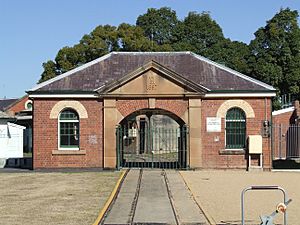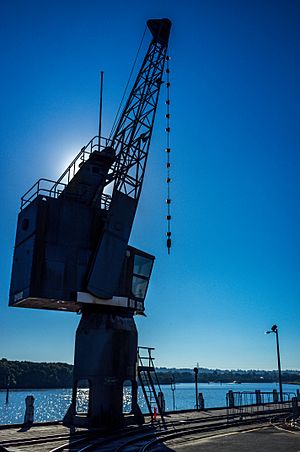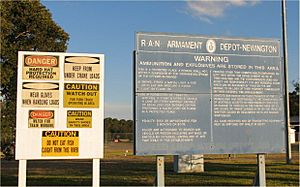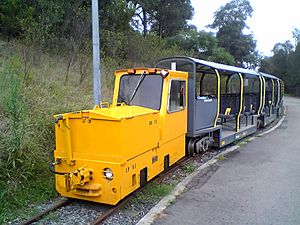Newington Armory facts for kids
Quick facts for kids Newington Armament Depot and Nature Reserve |
|
|---|---|

Newington Armory gatehouse
|
|
| Location | Holker Street, Sydney Olympic Park, Cumberland Council, New South Wales, Australia |
| Built | 1897–1999 |
| Architect | various |
| Owner | Sydney Olympic Park Authority |
| Official name: Newington Armament Depot and Nature Reserve; Millennium Heritage Parklands Precinct; Newington Armory; Royal Australian Navy Armament Depot (RANAD); Newington Nature Reserve; Sydney Olympic Games | |
| Type | state heritage (complex / group) |
| Designated | 14 January 2011 |
| Reference no. | 1850 |
| Type | Magazine |
| Category | Defence |
| Builders | Royal Australian Navy |
| Lua error in Module:Location_map at line 420: attempt to index field 'wikibase' (a nil value). | |
The Newington Armory is a special place in Sydney Olympic Park, New South Wales, Australia. It used to be a big storage area for weapons and ammunition for the Royal Australian Navy. It was built starting in 1897.
Today, the Armory is no longer used for military purposes. Instead, it's a popular spot for visitors and a nature reserve. It's also known by other names like Millennium Heritage Parklands Precinct and Newington Nature Reserve. The Sydney Olympic Park Authority now owns and manages this important historical site. It was officially added to the New South Wales State Heritage Register on 14 January 2011 because of its history and natural beauty.
Contents
History of Newington Armory
The area around the Parramatta River has been home to Aboriginal people for a very long time, possibly over 20,000 years. Evidence of their lives, like shell middens (piles of shells from meals), was found near Homebush Bay.
Later, in 1807, a man named John Blaxland came to Australia. He was given a large piece of land along the Parramatta River. He named his estate Newington. Blaxland focused on raising cattle and making salt. He built a farm and a salt works between 1829 and 1832. After he died, the land was sold and leased for different uses. Eventually, the government bought it back in 1880.
In the late 1800s, Sydney needed a new place to store explosives. The existing storage sites were getting too full and were too close to the growing city. Newington was chosen because it was isolated and had a lot of mud flats and swamps. This made it a good spot for storing dangerous materials safely away from people.
Construction of the military magazine (storage area) began in 1897. The first buildings were put up for the New South Wales Military Forces. These forces used the site to store all the gunpowder needed for military purposes in the colony.
In 1901, when Australia became a federation, the New South Wales Military Forces joined the new Australian Army. The Newington Magazine continued to support the Army until 1921.
In 1921, the site was transferred to the Department of Navy. The Navy needed more space to store explosives, especially to move them away from Spectacle Island. Over the next few decades, the Newington depot grew. It became a key place for the Navy to store ammunition for ships.
World War II greatly increased the importance of the Newington Armory. Thousands of Allied ships came to Sydney, needing ammunition and supplies. The Armory became a vital part of a network of Navy sites around Sydney Harbour. It stored ammunition for Australian, American, and British ships. All ships entering the harbour would unload their ammunition, which was then taken to Newington for safe storage.
After the war, the Navy continued to use the site. It was still important for moving ammunition from storage to ships. In the 1950s, some of the most dangerous explosives were moved to another depot outside Sydney. Newington continued to handle other types of explosives and was a main point for transferring ammunition by road and water.
For many years, animals like sheep and horses lived at the Armory. The sheep helped keep the grass short, and horses pulled carriages filled with armaments.
From Military to Olympic Park
In the 1970s, there were talks about closing the depot. This idea gained more attention in the 1980s. Finally, in 1994, it was announced that the depot would close. This was to make way for the 2000 Summer Olympics which would be held nearby at Homebush Bay.
The Navy began moving out in 1996. The southern part of the depot was turned into the Olympic Games Athlete's Village, which is now the suburb of Newington. The wetlands, which had been cut off from the river, were reconnected to allow tidal water back in.
The Navy officially left the site in December 1999. The last ammunition was moved from the wharf on December 14, 1999. The site was then given to the New South Wales State Government in January 2000. The remaining part of the Armory, with many of its original buildings, became part of Sydney Olympic Park. It is now known as the Newington Armory.
In 2000, a large part of the site became the Newington Nature Reserve. Since 2003, the Armory has been opened to the public. Buildings have been restored, and the old railway tracks are now used for visitor tours. In 2007, Blaxland Riverside Park opened next to the Armory, offering picnic areas and a riverfront walk.
What You Can See at Newington Armory Today
The Newington Armory and Nature Reserve covers about 100 hectares (about 247 acres). It has over 100 buildings, 6.7 kilometres (about 4 miles) of narrow-gauge railway tracks, and old battery-powered trains. You can also see cranes and other items left from when it was a military depot.
The site is divided into different zones based on when they were built and used:
- Original Establishment Precinct: This is the oldest part, near the Parramatta River. It has the wharf with two cranes and the first military buildings from 1897. These buildings were designed to store explosives safely, with earth mounds and concrete walls to protect against blasts. There are also administration and housing buildings on a hill nearby.
- Early Navy Occupancy Precinct: In the north-east, this area shows how the Navy expanded the site before World War II. It has many buildings for storing weapons and testing them. This area was chosen because it was isolated by wetlands.
- RAN Wartime Expansion Precinct: This part in the south-east has buildings built just before and during World War II. These were used for storing armaments, testing, and administration. It also includes transport systems from that time.
- US Navy Utilisation Precinct: In the south-west, this area has special bunkers built for the US Navy during World War II to store explosives. There are also offices and workshops from that time. Many of the old storage buildings were built with special features to prevent static electricity and protect against lightning.
The Armory also has a unique collection of old Navy items. These items are directly linked to the history of the Newington site. Many of them are very rare or the only ones known to exist.
Newington Nature Reserve: A Home for Wildlife
The Newington Nature Reserve is a very important part of the site. It's protected because of its amazing natural environment. It has 48 hectares (about 118 acres) of forests and wetlands.
The Reserve is home to a special type of forest called "Sydney Turpentine Ironbark Forest." This forest is critically endangered, meaning very little of it is left. It has many old trees with hollows, which are perfect nesting spots for birds and bats. It's a key place for many bush birds and bats in the Sydney area.
The Reserve also has a large wetland area. This includes mangrove forests, mudflats, and saltmarsh. These are also endangered ecological communities. The saltmarsh is home to rare plants.
This reserve is the only place on the Parramatta River estuary where you can see a complete natural progression of environments: from eucalypt forest, to casuarina forest, to saltmarsh, and then to mangroves.
It's also a very important home for animals:
- It has the only known maternity roost (a place where mother bats raise their babies) of the White-striped Freetail bat in Sydney. This roost is inside an old explosives storehouse.
- It supports a population of the Green and Golden Bell Frog, which is an endangered species.
- About 144 different types of birds live here, including birds that migrate from other countries.
- It's one of only two places in Sydney where the White-fronted Chat, a vulnerable bird species, can be found.
Exploring the Armory: Railway and Wharf
The site has a narrow-gauge electric railway. This railway used to transport ammunition. Now, battery-powered trains take visitors on tours around the Armory. These tours run on Sundays and during school holidays.
The wharf on the Parramatta River was once used to ship ammunition. Today, it's sometimes used by Sydney Ferries as a temporary stop for their river services.
Australian Scout Museum
The Australian Scout Museum is located inside the old sandstone gatehouse near the Armory Wharf. It's a great place to learn about the history of scouting in Australia.
Current Condition and Use
Since the Armory closed in the 1990s, parts of it have been redeveloped into the suburb of Newington. However, the remaining Armory precinct is well-maintained. Many of the original buildings are still in good condition.
Today, the site is used for many different activities. It's a place for recreation, cultural events, arts, science, and education. Some buildings have been repurposed into a cafe, visitor information centre, art studios, an art gallery, and even accommodation. The railway has been restored and offers guided tours for visitors.
The forests and wetlands are also in good condition. They are carefully managed to protect the rare plants and animals that live there. Access to some sensitive areas is restricted to keep them safe.
Why Newington Armory is Important
The Newington Armory and Nature Reserve is very important for New South Wales. It shows how explosives were handled and stored from the 1890s all the way to 1999. It also highlights Sydney's role as a major Navy port. The site gives us clues about early European settlement and the development of defence in Australia.
It's also important as a large cultural landscape. It has features from all parts of its history, along with rare forests and wetlands. The Newington Nature Reserve is protected because of its significant natural value. Its wetlands and forests are rare examples of what the area used to look like. They are home to many endangered plants and animals, including the Sydney Turpentine Ironbark Forest, Coastal Saltmarsh, the Green and Golden Bell Frog, and the White-striped Freetail bat. It's the only place on the Parramatta River that has a complete natural progression of different forest and wetland types.
The Newington Armory is historically significant because it shows the early European settlement along the Parramatta River. It was part of John Blaxland's estate, an important early settler. The site also shows the big role the Royal Australian Navy and the US Navy played in World War II.
The Armory has a unique mix of old buildings, some partly hidden by earth mounds, within an open parkland setting next to the forest and river. This creates a remarkable landscape. The old brick buildings from the turn of the century show how industrial buildings were designed back then.
The Armory is also important to the Navy employees and their families who lived and worked there for many years.
It's a great place for research, especially about how explosives handling and storage technology changed over time. The buildings built for the US Navy during World War II are special examples of military storage technology.
The research done in the endangered wetlands and forests helps us understand how to protect these special natural areas. This knowledge can also help manage similar ecosystems elsewhere.
The Royal Australian Navy Armament Depot at Newington was unique in New South Wales. It was the main place for storing and supplying explosive Navy weapons for the Sydney Harbour fleet from 1895 to 1998. It was the only site in NSW where the Australian, US, and British Navies all operated together.
The site is home to three "endangered ecological communities": Coastal Saltmarsh, Swamp Oak Floodplain Forest, and Sydney Turpentine Ironbark Forest. The Turpentine Ironbark Forest is even listed as critically endangered. The nature reserve is the only remaining example on the Parramatta River of a complete natural zone from tidal mudflats, to mangroves, saltmarsh, swamp oak forest, and eucalypt forest. Almost all other similar areas in Sydney have been cleared.
It's also home to an endangered population of the White-fronted Chat bird and the saltmarsh plant Wilsonia backhousei. The Green and Golden Bell Frog population here is also endangered. The site is the only known maternity roost for the White-striped Freetail Bat in Sydney, and the only one found in a building. It hosts 144 bird species and 10 bat species, including migratory shorebirds.
Newington Armaments Depot is an excellent example of an armament depot that changed and grew throughout the 20th century. Its remaining parts show all the different periods of its history.




